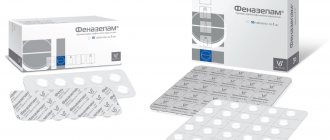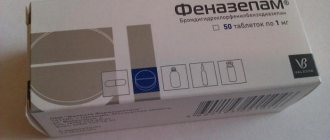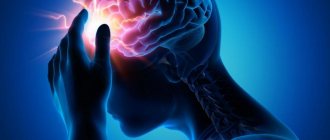Phenazepam is a benzodiazepine tranquilizer, widely used in the practice of many doctors. Its main advantages are proven effectiveness and accessibility. It is the drug of choice for mental and neurological diseases, various types of substance addiction, and in many other cases. But the drug also has negative sides.
Phenazepam has a large number of side effects and contraindications. The most common side effect is drowsiness, but bradycardia, decreased blood pressure, dyspeptic disorders and much more also occur. A wide range of contraindications includes both certain diseases of internal organs and use in combination with other substances.
The compatibility of phenazepam with alcohol has been most studied. The fact is that the drug is used in the treatment of alcohol addiction. Some patients, after prescribing the drug, violate the instructions: they continue to drink alcohol, which causes a number of negative consequences, which are currently well studied.
Alcohol and phenazepam are completely incompatible with each other. The use of these two substances at the same time is strictly contraindicated. Neglecting these rules sometimes ends in death.
Reasons for incompatibility
Phenazepam, like all benzodiazepine tranquilizers, increases the amount of inhibitory transmitters in the neurons of the central nervous system. This leads to inhibition of the activity of nerve cells and causes a sedative effect.
Ethanol has a similar effect. Its breakdown products are toxic to brain cells. First, they increase the concentration of substances responsible for pleasure, and then inhibit the activity of all central nervous system centers. The greater the dose of alcohol, the stronger the depression.
Phenazepam and alcohol potentiate each other's effects. However, the effect is not limited to conventional sedation. Any centers of the brain may stop functioning, including those responsible for vital functions. Drinking even small amounts of alcohol in combination with low doses of phenazepam can lead to significant depression of central nervous system cells.
What can increase adverse reactions?
Phenazepam causes adverse reactions even when the dosage is observed. However, there are a number of restrictions, non-compliance with which can increase the severity of side effects and lead to coma or death. Among the restrictions are:
- Combination with alcoholic drinks, which causes the development of persistent dependence. Ethanol not only causes its own side reactions, but also enhances the effect of bromodihydrochlorophenylbenzodiazepine in the composition.
- Combination with sleeping pills and tranquilizers. These drugs inhibit the functions of the nervous system and affect a person’s mental state. This combination increases the likelihood of adverse reactions from the central nervous system, mental health disorders, even suicide. Therefore, before prescribing the drug, it is important to inform your doctor about taking other medications.
The severity of side effects also increases when the dosage is exceeded.
Consequences of taking phenazepam and alcohol
The specific consequences depend on the dosage of the drug, the amount of alcohol and the sensitivity of the patient's body. Most often, general depression develops - confusion, stupor, stupor, coma, pathological drowsiness.
From the cardiovascular system, there is a pronounced decrease in heart rate and a drop in blood pressure. Reduced breathing may occur. Sometimes paradoxical reactions occur associated with hyperexcitation of the cerebral cortex and subcortical structures. Such reactions are called pathological intoxication.
Pathological intoxication is the development of symptoms of mental illness when drinking a small amount of alcohol. Accompanied by hallucinations, delusions, motor activity, and confusion. Sometimes convulsions develop, similar to an epileptic attack.
An overdose of phenazepam while drinking alcohol can result in death. The lethal dose of phenazepam is 10 mg.
Dosage, release forms and manufacturers
Phenazepam for panic attacks and VSD relieves anxiety and improves well-being. If taken regularly, the medication will help well even in small doses.
One of the common causes of overdose is unauthorized excess of the therapeutic dose. Patients believe that since the pill improves the condition of VSD, then after taking 2 pills the anxiety will completely disappear. But increasing the dosage of Phenazepam, at best, will lead to severe drowsiness, and in some people it can cause life-threatening disorders:
- increased blood clotting and the formation of intravascular blood clots;
- the appearance of suicidal thoughts;
- hallucinations;
- convulsions;
- pain in the stomach caused by irritation of the mucous membrane;
- liver dysfunction;
- heart rhythm failure.
Another common cause of overdose is prolonged use. Despite the fact that Phenazepam is available only by prescription, some patients with VSD find a way to “get” the medication and take it for several months or even a year, becoming drug dependent. But constant use of Phenazepam leads to the fact that the drug “accumulates” in the body, negatively affecting health.
Signs of an overdose may appear when taking Phenazepam and alcohol together. This is due to the fact that ethanol enhances the effect of the drug.
Sometimes a patient with VSD thinks that since he didn’t take a pill today, he can drink alcohol. But Phenazepam is eliminated for a long time and in some people, 5 days after the last dose of the drug, a small amount of metabolites is found in the plasma.
Phenazepam is available in two main forms: tablets and injection solutions. Each ampoule of injection solution contains 1 mg of active substance per 1 ml of liquid.
Important! The medication is available only in ampoules of 1 ml. There is no alternative form of release of the injection solution.
Tablets on pharmacy shelves can be found in three dosages: 0.5 mg, 1 mg or 2.5 mg. It is worth remembering that the selection of the optimal dose is made by the attending physician.
There are many pharmaceutical companies producing Phenazepam. Among them:
- Valens;
- Moskhimfarmpreparaty im. Semashko;
- Akrikhin et al.
There are also many foreign companies producing the drug under other trade names.
Treatment of alcoholism with phenazepam
Phenazepam is used to treat alcohol withdrawal, popularly called “withdrawal.” Withdrawal syndrome occurs a few days after the complete cessation of alcohol consumption in people who have been abusing them for a long time. It is manifested by attacks of aggression, agitation, unreasonable excitement, hallucinations, and delusions. This condition is treated with tranquilizers and other sedatives.
Phenazepam is often the drug of choice because it is highly effective and low cost. You can use this remedy for alcohol dependence, but you should not mix it with alcohol. To exclude the interaction of two substances, a certain scheme is used.
Contrary to popular belief, alcoholism cannot be cured with phenazepam. This drug only helps fight the symptoms that occur in addicts when withdrawing from alcohol.
Video about taking the drug
The main active ingredient in Phenazepam is bromodihydrochlorophenylbenzodiazepine.
This is a white or slightly creamy powder, thanks to which it is possible to achieve muscle relaxant, hypnotic, anticonvulsant, anti-anxiety and a number of other effects. In addition to the main active ingredient, the drug Phenazepam contains a number of excipients that provide the necessary consistency and preservation of properties. The tablets may contain potato starch, lactose, talc and a number of other substances. The injection solution contains povidone, glycerol, sodium disulfite, etc.
Once again about phenazepam
PHENAZEPAM BRAIN RESET TRANQUILIZERS IN THE TREATMENT OF PANIC ATTACKS, VSD, ANXIETY
Instructions for using phenazepam with alcohol
Phenazepam is prescribed when alcohol withdrawal syndrome develops. This happens after it is completely removed from the body. In this case, the danger of interaction is eliminated. If the drug is prescribed to someone who is currently abusing alcohol, you should wait 2 days after drinking alcohol.
If, on the contrary, the patient wants to drink alcohol during treatment with phenazepam, regardless of the reasons for its prescription, you should wait a few days. The half-life of the drug is 12 hours. This means that after 12 hours, half of the dose taken will remain in the blood. After another 12 hours - half half and so on. Considering this fact and therapeutic doses, we can say that you should drink alcohol no less than 2-3 days after stopping treatment with phenazepam.
At the same time, it is worth remembering that you cannot stop taking the drug at once. Side effects may also develop when phenazepam is discontinued. First, gradually reduce the dose of the medication, then stop taking it completely, wait at least 2 days, after which you can drink alcohol. However, discontinuation of the drug must be agreed with the attending physician. Stopping treatment on your own can lead to serious consequences.
Contraindications
In case of VSD, taking Phenazepam is prohibited if the patient has a history of:
- kidney disease;
- heart pathologies;
- myasthenia gravis;
- recent stroke.
Phenazepam should not be prescribed if the patient is in a coma or in a state of shock.
It is prohibited for children under 18 years of age to take the medicine during pregnancy and breastfeeding. If a nursing woman needs treatment for VSD, then during therapy the baby is fed formula.
Phenazepam can be used for various anxiety disorders due to the following effects of the drug:
- anxiolytic i.e. anti-anxiety, achieved by inhibiting the area of the brain responsible for emotions;
- sedative, capable of having a stabilizing effect on the patient’s emotional state, reducing his susceptibility to various external situations;
- a sleeping pill that makes it easier to fall asleep, reduces the frequency of awakenings at night, and generally improves the quality of sleep;
- muscle relaxant i.e. relaxes muscles by inhibiting nerve conduction in general;
- anticonvulsant i.e. allowing to stop a convulsion or epileptic seizure.
Today, doctors prescribe Phenazepam for strictly defined indications. Among them:
- neurotic and neurosis-like states, mental disorders accompanied by anxiety, increased irritability, attacks of fear, lability of emotions;
- reactive type psychoses;
- hypochondriacal-synesopathic syndrome;
- various sleep disorders, autonomic dysfunctions;
- to combat acute attacks of fear, emotional stress;
- as an anticonvulsant drug to combat temporal and myoclonic forms of epilepsy;
- in neurology to get rid of tics, hyperkinesis, autonomic lability, etc.
Phenazepam is not used for myasthenia gravis, poisoning with a number of tranquilizers, antipsychotics, sleeping pills, and narcotic analgesics. A serious contraindication is during pregnancy and lactation, as well as disorders of the liver and kidneys.
Reviews
Ilya E .: “I was treated by a narcologist for a long time about alcohol addiction. I couldn’t bear the lack of my favorite drinks very well, so I took phenazepam. The drug helped me cope with a difficult period in my life. It suppresses irritability and calms well. I took it while I was in a bind. An excellent incentive not to drink, I saw what happens to those who drink phenazepam and alcohol at the same time. Apparently, they felt very bad, so I didn’t drink. Phenazepam helped me cope.”
Kirill M .: “I took phenazepam prescribed by the doctor. I was warned not to drink alcohol, but I didn't take it seriously. This is how they talk about many drugs, and nothing happens. During the course of treatment I had the imprudence to drink a glass of beer with friends. I don’t know what happened to me next. 4 days fell out of my life. As it turned out, I spent them in intensive care in an unconscious state. I stopped taking Phenazepam, now I’m afraid.”
Review from a narcologist : “I often use phenazepam in the treatment of alcohol withdrawal. The drug is very effective, especially in patients with agitation, attacks of aggression, and insomnia. Phenazepam eliminates all these symptoms quite quickly. The only downside is that you need to closely monitor the patient. Many patients break down and drink alcohol, despite the ban. The consequences can be different, including death. I prescribe phenazepam only to those patients who are in the hospital, since they can be controlled, and I treat them on an outpatient basis with other medications.”
Content
Summing up
The product has undeniable effectiveness in treating epilepsy, stress conditions, sleep disorders, migraines, and feelings of fear. But with an overdose, all the positive qualities change to the exact opposite, so a sharp change in mood can occur. With long-term use, dependence on the drug develops.
Before using Phenazepam, you should carefully study the instructions, which indicate side effects and contraindications, and also study reviews from doctors and ordinary people.
Practical experience shows that this remedy should be treated with extreme caution and should never be used without a doctor’s prescription. Therefore, experiments are inappropriate here.
Instructions for use:
Prices in online pharmacies:
Mistakes made by patients when treating VSD
Phenazepam, when taken as prescribed by a doctor, helps alleviate the symptoms of VSD, but some patients complain that the medicine does not help or that taking Phenazepam has made them worse. Let's look at common mistakes made by patients:
- Lack of complex therapy. A person begins to treat VSD with Phenazepam, instead of eliminating the cause of dystonia. Phenazepam does not treat VSD, but only relieves severe symptoms.
- Irregular intake. People are afraid that the medicine will be addictive and try to take pills only during times of severe stress. But for neuroses, you need to take Phenazepam daily, throughout the entire therapeutic course.
- Exceeding the treatment course. Addiction to Phenazepam is manifested not only by the return of VSD symptoms when the drug is abruptly discontinued. The body gets used to the constant action of the medication, and this leads to the fact that Phenazepam acts weaker and does not effectively eliminate fears, panic and other manifestations of VSD.
In case of VSD, Phenazepam will help eliminate the symptoms that have arisen, restore sleep and reduce anxiety. But it should be remembered that Phenazepam does not cure, but only reduces the severity of the manifestations of VSD. To get rid of vegetative-vascular disorders, it is necessary to cure the provoking disease.
Found a mistake? Select it and press Ctrl Enter
Doctors almost unanimously note that Phenazepam is a drug that helps achieve positive dynamics in anxiety disorders. If the drug is used according to the instructions and in accordance with the indications, it is, as doctors say, well tolerated and has mild side effects.
Patients note in their reviews that Phenazepam is a remedy that combines effectiveness and low cost. Among the disadvantages, first of all, serious age restrictions are mentioned, which do not allow the use of the medicine to treat a child, as well as restrictions during lactation and pregnancy.
Side effects of Phenazepam
The negative consequences of taking a medication can be associated not only with its effect on the nervous system, but also with malfunctions of other internal organs. Most often, the situation is limited to a decrease in physical activity, drowsiness, lethargy, and a feeling of constant fatigue.
The summary of the drug indicates the possibility of developing the following adverse reactions:
- decreased functionality of the central nervous system in the form of problems with concentration, dizziness, headaches, speech depression, coordination disorders;
You will learn about other reasons that can cause headaches in this article.
- dementia and senile dementia in people over 65 years of age;
- increased manifestation of the symptoms that the treatment was aimed at combating. Very rarely this takes the form of insomnia, hallucinations, aggression, muscle spasms;
- decreased libido in both sexes, erection problems in men;
- a decrease in blood pressure to pathological levels with initially low numbers;
- deterioration of the liver and kidneys due to the toxic effects of the main component on these organs;
- changes in blood composition;
- dyspeptic disorders in the form of dry mouth, loss of appetite, constipation, diarrhea, nausea;
- allergic reactions of various types and severity;
- drug addiction type;
- weight loss;
- heart rhythm disturbances.
Some consequences develop immediately after taking the product, others become the result of course therapy. The decision on the advisability of further use of the drug is made by the doctor based on signs of positive dynamics of the main treatment and the severity of adverse reactions.










